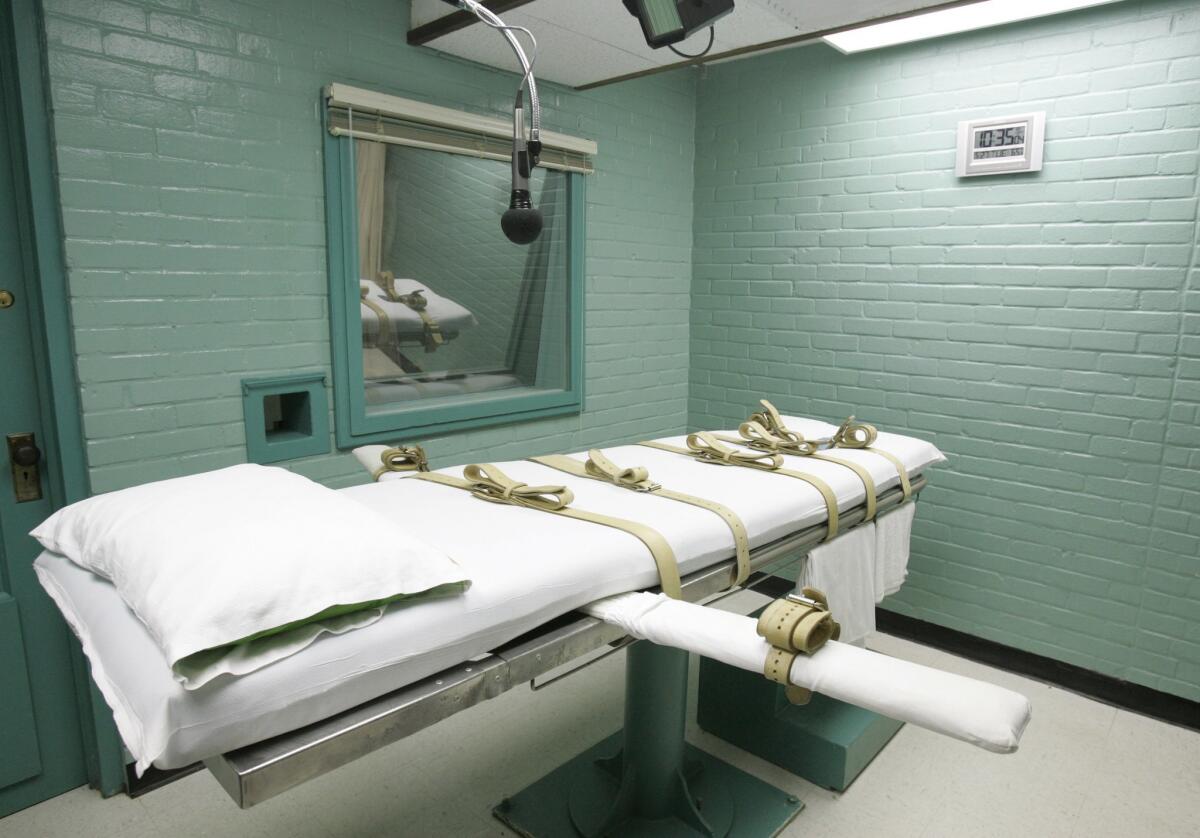Connecticut court wisely bars execution of death row inmates

The Connecticut Supreme Court’s decision Thursday barring execution of its 11 death row inmates is part of a shift in approach to the death penalty that has even affected perennial execution leader Texas, whose lethal-injection chamber is pictured above.
The Connecticut Supreme Court added Thursday to growing legal opinions questioning the fundamental arbitrariness of capital punishment in the United States. Let’s hope a couple of the pro-death penalty U.S. Supreme Court justices are following along – with open minds.
The details of the Connecticut case are straightforward. Eduardo Santiago hired himself out in 2000 to murder the lover of a woman with whom a friend of his had a romantic interest (his payment: a snowmobile), according to prosecutors. Santiago was convicted, condemned to death, and mounted the usual appeals with mixed results. The state Supreme Court upheld most of the decisions against Santiago but also found that the prosecution failed to divulge potentially mitigating information that could have affected the jury’s decision to sentence Santiago to death, and sent that part of the case back for reconsideration.
In the meantime, the state of Connecticut banned applying the death penalty to anyone convicted of what had been a capital crime as of April 25, 2012, the effective date of the repeal. Santiago filed a new motion “in which he asked this court to consider, among other things, whether the prospective repeal leads inexorably to the conclusion that capital punishment has ceased to comport with state constitutional requirements.”
The court ruled that it did, since by passing Public Act 12-5 banning the practice, the state effectively said that the death penalty was no longer reflective of the people’s values, so it was illogical to execute someone simply because of the timing of the crime for which he had been convicted. Specifically, the court held that the death penalty “no longer comports with contemporary standards of decency and no longer serves any legitimate penological purpose. The adoption of [the repeal], when considered in light of the history of capital punishment in our state and other recent legal developments, compels us to conclude that the death penalty now constitutes cruel and unusual punishment, in violation of the state constitution.”
The decision dovetails somewhat with the ruling last year (which is under appeal) by U.S. District Court Judge Cormac J. Carney in Santa Ana, who said the inherent arbitrary nature of who gets executed in California – based in large part on the state’s underfunded and jammed-up process – made the death penalty unconstitutional at the federal level. And it fits with a broad shift in approaches to the death penalty (even in Texas), as detailed here.
This (long) paragraph from the Connecticut ruling cuts to the chase:
“Public Act 12-5 not only reflects this state’s longstanding aversion to carrying out executions, but also represents the seminal change in the four century long history of capital punishment in Connecticut. Accompanying this dramatic departure are a host of other important developments that have transpired over the past several years. Historians have given us new chronicles of the history and devolution of the death penalty in Connecticut. Legal scholars have provided new understandings of the original meaning of the constitutional prohibition against cruel and unusual punishments. Social scientists repeatedly have confirmed that the risk of capital punishment falls disproportionately on people of color and other disadvantaged groups. Meanwhile, nationally, the number of executions and the number of states that allow the death penalty continue to decline, and convicted capital felons in this state remain on death row for decades with every likelihood that they will not be executed for many years to come, if ever. Finally, it has become apparent that the dual federal constitutional requirements applicable to all capital sentencing schemes — namely, that the jury be provided with objective standards to guide its sentence, on the one hand, and that it be accorded unfettered discretion to impose a sentence of less than death, on the other — are fundamentally in conflict and inevitably open the door to impermissible racial and ethnic biases. For all these reasons, and in light of the apparent intent of the legislature in prospectively repealing the death penalty and this state’s failure to implement and operate a fair and functional system of capital punishment, we conclude that the state constitution no longer permits the execution of individuals sentenced to death for crimes committed prior to the enactment of P.A. 12-5.”
The decision, obviously, applies only to Connecticut and the 11 people on its death row, but the condemnation of the death penalty can be applied more widely. There is a growing movement in this country away from the barbarity of the death penalty – Connecticut this week, Nebraska in May (though there’s a move there to reinstate it), Maryland two years ago. Four other states have governor-imposed moratoriums, rooted in skepticism about the fairness of the system.
In fact, how’s this for arbitrary: A handful of counties – not states but counties – account for the majority of the nation’s death sentences. And fewer and fewer juries and judges are imposing the death sentence, presumably in light of growing revelations of prosecutors gaming the process, studies spotlighting the inconsistency in its application, and exonerations of wrongfully convicted people sentenced to death.
In a June ruling, the U.S. Supreme Court upheld Oklahoma’s three-drug execution protocol, but Justice Stephen G. Breyer in a stirring and persuasive dissent (joined by Justice Ruth Bader Ginsburg), urged the court to take a fresh look at capital punishment, which it reinstated in 1976 after a four-year hiatus, and whether the mood of the nation, and knowledge of the system’s failings, made the practice a violation of the 8th Amendment.
“In 1976, the Court thought that the constitutional infirmities in the death penalty could be healed; the Court in effect delegated significant responsibility to the States to develop procedures that would protect against those constitutional problems,” Breyer wrote. “Almost 40 years of studies, surveys, and experience strongly indicate, however, that this effort has failed. Today’s administration of the death penalty involves three fundamental constitutional defects: (1) serious unreliability, (2) arbitrariness in application, and (3) unconscionably long delays that undermine the death penalty’s penological purpose. Perhaps as a result, (4) most places within the United States have abandoned its use.”
Whether there could be enough votes on this Supreme Court to end this immoral practice is a big question mark. Some seem set in stone, such as Justice Antonin Scalia, who once wrote that no innocent people had been executed (wrong). But one hopes the growing evidence that the system is arbitrary in meting out death sentences and in determining who ultimately gets executed, that it is riddled with wrongful convictions, and that the innocent have likely been put to death, may be enough to persuade another justice or two to, well, embrace justice and remove this stain from the nation’s soul.
Follow Scott Martelle on Twitter @smartelle.
More to Read
A cure for the common opinion
Get thought-provoking perspectives with our weekly newsletter.
You may occasionally receive promotional content from the Los Angeles Times.











